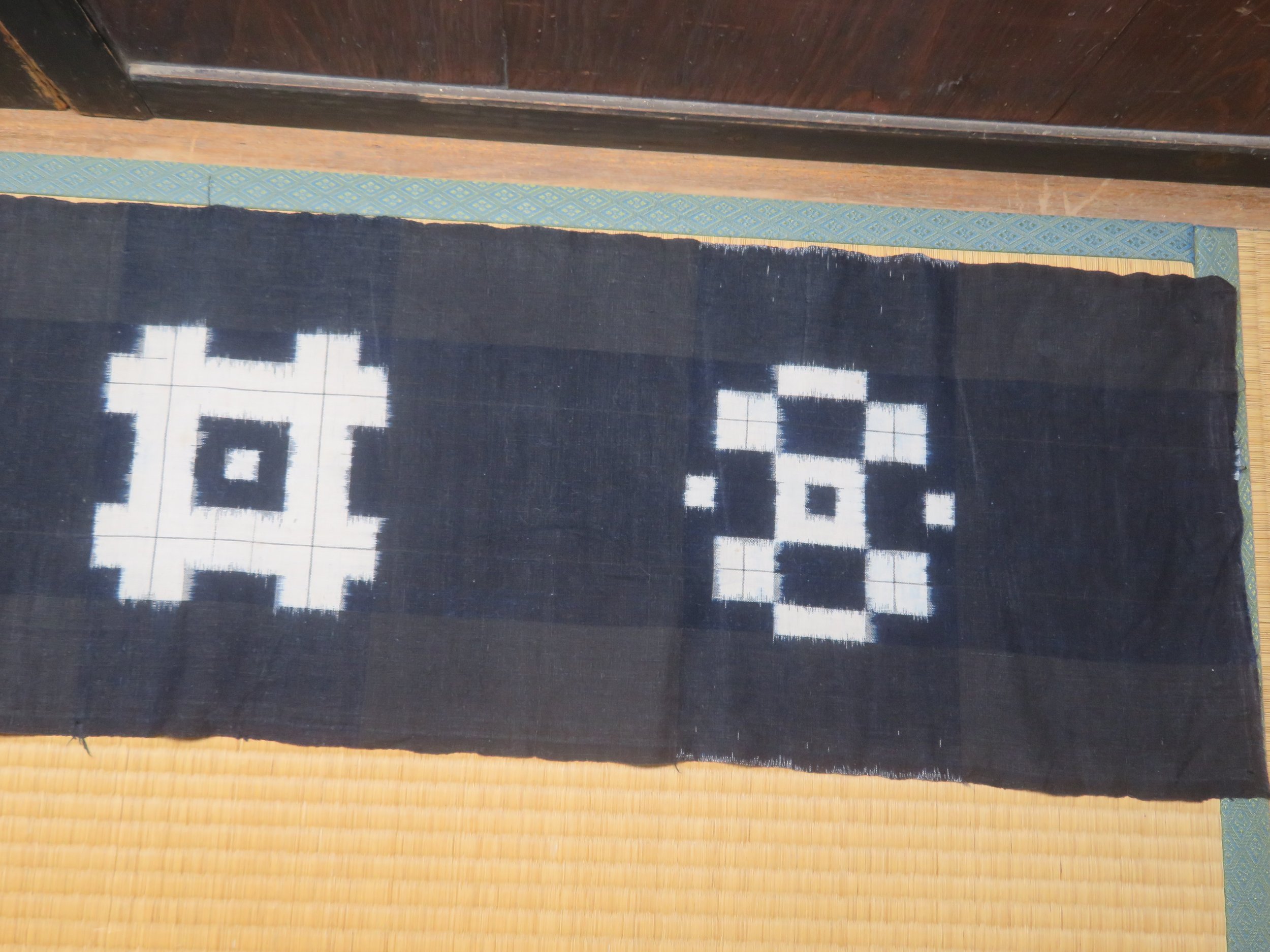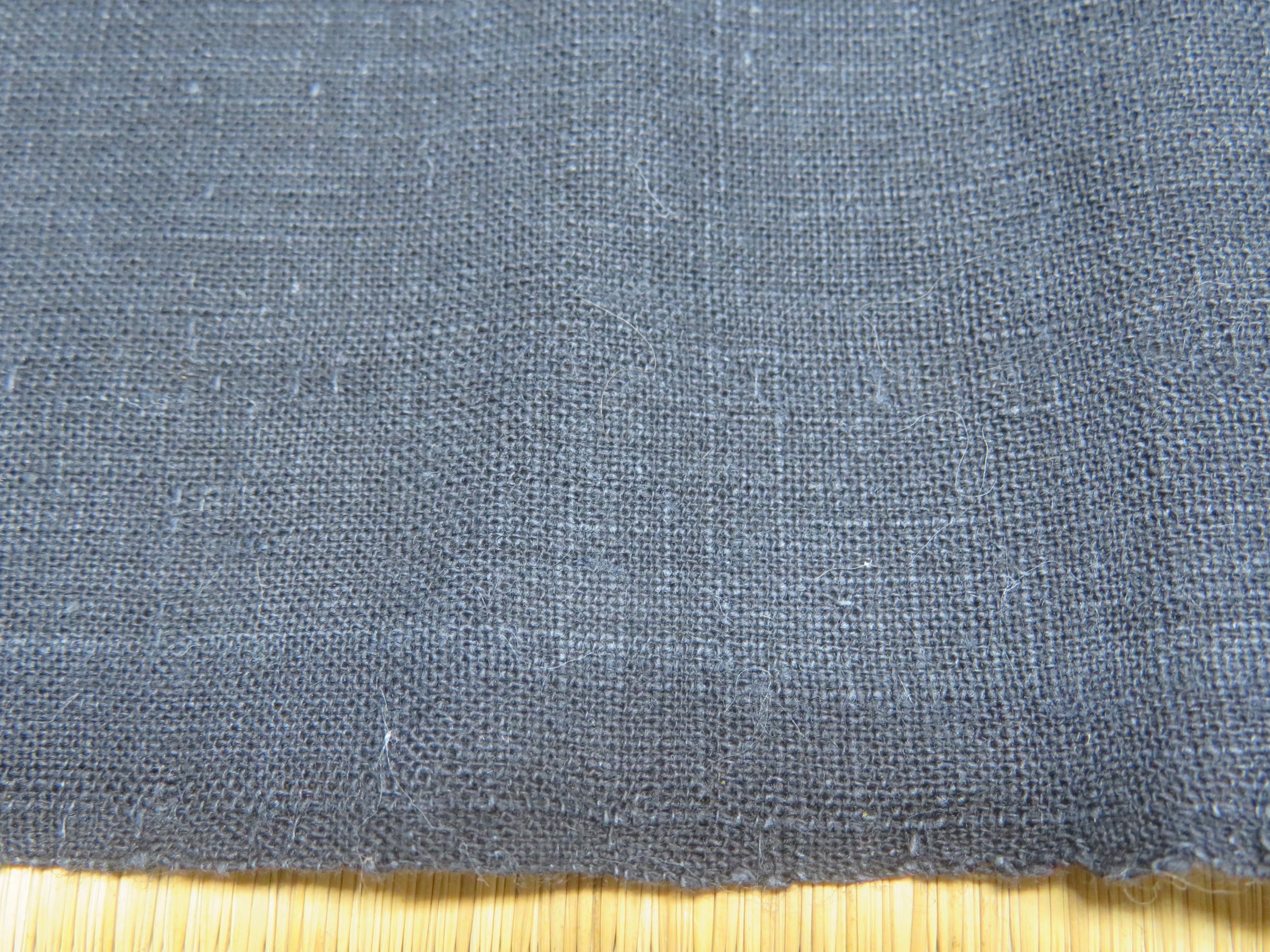 Image 1 of 17
Image 1 of 17

 Image 2 of 17
Image 2 of 17

 Image 3 of 17
Image 3 of 17

 Image 4 of 17
Image 4 of 17

 Image 5 of 17
Image 5 of 17

 Image 6 of 17
Image 6 of 17

 Image 7 of 17
Image 7 of 17

 Image 8 of 17
Image 8 of 17

 Image 9 of 17
Image 9 of 17

 Image 10 of 17
Image 10 of 17

 Image 11 of 17
Image 11 of 17

 Image 12 of 17
Image 12 of 17

 Image 13 of 17
Image 13 of 17

 Image 14 of 17
Image 14 of 17

 Image 15 of 17
Image 15 of 17

 Image 16 of 17
Image 16 of 17

 Image 17 of 17
Image 17 of 17


















Antique Indigo Kasuri FABRiC panel 146 cms
Here we have a nice long panel of indigo cotton kasuri which no doubt came from a futon cover fabric. It is hand woven, or homespun, as they say, and the selvedges are rather uneven. It looks nice, organic. It is a medium weight fabric in great condition for its age. I estimate it is from the earlier part of the twentieth century, or perhaps a bit older. Late Meiji or Taisho era.
These mingei kasuri textiles with two alternating patterns seem to be a standard type. It seems that something like this would be good for the learning weaver, to slowly challenge themselves and level up, so to speak, with progressively difficult patterns. Perhaps there are patterns which were specifically aimed at the winter weavers, the folks holed up with no farming to do in the winter. Many winter tasks were centered around the various steps of textile production, as anything you could provide for yourself meant more money to spend elsewhere for the frugal japanese peasants. The grew their own cotton and silk cocoons, so there was the processing of these raw materials, as well as spinning and weaving.
The two patterns seem to be a play on the character for ‘well’, or 井. It is like a tic tac toe game or something…or a cross….
Kasuri is the japanese way to say ikat. This is a complex process where the strings of the warp and weft are dyed prior to the weaving, employing various methods of resist dyeing, like tiedyeing and resist pastes. A pattern is planned out and dyed into the fibers before the actual weaving. So when the fabric is woven up, we get the telltale fuzziness of pattern that is a characteristic of kasuri fabrics.
One thing we can often see with kasuri fabrics is a line of little white marks at the side. In this fabric , these marks are only where there is pattern. The blank areas have no such marks. These marks are dyed into the fabric like registration marks. The weaver can use these to line up the pattern while it is on the loom. You can see these lines well in the sixth photo above.
Another fun thing I notice as a dyer myself is how the areas which have pattern also seem to have ever so slightly bluer indigo where the pattern is, and ‘blacker’ indigo in the solid areas. The areas with pattern had to be resist dyed in indigo in some manner to get the white to be where it needed to be. Needless to say, they were dyed separately from the solid color fibers, resulting in that difference.
This fabric, being hand woven, also has uneven selvedges, meaning the sides are not perfectly straight. This is the hand-made flavor which i love in these old mingei treasures. There are some rows within the patterned areas which are slightly out of whack, not perfectly lined up. I love finding these spots where one can see the makers hand. I call them the human factor, and they can transform a regular fabric to a treasure.
This really could be used in so many ways. As a scarf!! Add patches and stitching and make it your own boro scarf. Or as fabric for really anything. Garments, projects, pillows, quilting, patchwork, you name it! One half of the panel would even make a great display piece which you could incorporate into your life in a number of ways. On the wall or draped across furniture, it is bound to change the aesthetic.
smells fine, clean and ready to use
I don’t see any holes at all!!
dimensions
146 cms x 33.5 cms
57.5 inches x 13 inches
Here we have a nice long panel of indigo cotton kasuri which no doubt came from a futon cover fabric. It is hand woven, or homespun, as they say, and the selvedges are rather uneven. It looks nice, organic. It is a medium weight fabric in great condition for its age. I estimate it is from the earlier part of the twentieth century, or perhaps a bit older. Late Meiji or Taisho era.
These mingei kasuri textiles with two alternating patterns seem to be a standard type. It seems that something like this would be good for the learning weaver, to slowly challenge themselves and level up, so to speak, with progressively difficult patterns. Perhaps there are patterns which were specifically aimed at the winter weavers, the folks holed up with no farming to do in the winter. Many winter tasks were centered around the various steps of textile production, as anything you could provide for yourself meant more money to spend elsewhere for the frugal japanese peasants. The grew their own cotton and silk cocoons, so there was the processing of these raw materials, as well as spinning and weaving.
The two patterns seem to be a play on the character for ‘well’, or 井. It is like a tic tac toe game or something…or a cross….
Kasuri is the japanese way to say ikat. This is a complex process where the strings of the warp and weft are dyed prior to the weaving, employing various methods of resist dyeing, like tiedyeing and resist pastes. A pattern is planned out and dyed into the fibers before the actual weaving. So when the fabric is woven up, we get the telltale fuzziness of pattern that is a characteristic of kasuri fabrics.
One thing we can often see with kasuri fabrics is a line of little white marks at the side. In this fabric , these marks are only where there is pattern. The blank areas have no such marks. These marks are dyed into the fabric like registration marks. The weaver can use these to line up the pattern while it is on the loom. You can see these lines well in the sixth photo above.
Another fun thing I notice as a dyer myself is how the areas which have pattern also seem to have ever so slightly bluer indigo where the pattern is, and ‘blacker’ indigo in the solid areas. The areas with pattern had to be resist dyed in indigo in some manner to get the white to be where it needed to be. Needless to say, they were dyed separately from the solid color fibers, resulting in that difference.
This fabric, being hand woven, also has uneven selvedges, meaning the sides are not perfectly straight. This is the hand-made flavor which i love in these old mingei treasures. There are some rows within the patterned areas which are slightly out of whack, not perfectly lined up. I love finding these spots where one can see the makers hand. I call them the human factor, and they can transform a regular fabric to a treasure.
This really could be used in so many ways. As a scarf!! Add patches and stitching and make it your own boro scarf. Or as fabric for really anything. Garments, projects, pillows, quilting, patchwork, you name it! One half of the panel would even make a great display piece which you could incorporate into your life in a number of ways. On the wall or draped across furniture, it is bound to change the aesthetic.
smells fine, clean and ready to use
I don’t see any holes at all!!
dimensions
146 cms x 33.5 cms
57.5 inches x 13 inches
Here we have a nice long panel of indigo cotton kasuri which no doubt came from a futon cover fabric. It is hand woven, or homespun, as they say, and the selvedges are rather uneven. It looks nice, organic. It is a medium weight fabric in great condition for its age. I estimate it is from the earlier part of the twentieth century, or perhaps a bit older. Late Meiji or Taisho era.
These mingei kasuri textiles with two alternating patterns seem to be a standard type. It seems that something like this would be good for the learning weaver, to slowly challenge themselves and level up, so to speak, with progressively difficult patterns. Perhaps there are patterns which were specifically aimed at the winter weavers, the folks holed up with no farming to do in the winter. Many winter tasks were centered around the various steps of textile production, as anything you could provide for yourself meant more money to spend elsewhere for the frugal japanese peasants. The grew their own cotton and silk cocoons, so there was the processing of these raw materials, as well as spinning and weaving.
The two patterns seem to be a play on the character for ‘well’, or 井. It is like a tic tac toe game or something…or a cross….
Kasuri is the japanese way to say ikat. This is a complex process where the strings of the warp and weft are dyed prior to the weaving, employing various methods of resist dyeing, like tiedyeing and resist pastes. A pattern is planned out and dyed into the fibers before the actual weaving. So when the fabric is woven up, we get the telltale fuzziness of pattern that is a characteristic of kasuri fabrics.
One thing we can often see with kasuri fabrics is a line of little white marks at the side. In this fabric , these marks are only where there is pattern. The blank areas have no such marks. These marks are dyed into the fabric like registration marks. The weaver can use these to line up the pattern while it is on the loom. You can see these lines well in the sixth photo above.
Another fun thing I notice as a dyer myself is how the areas which have pattern also seem to have ever so slightly bluer indigo where the pattern is, and ‘blacker’ indigo in the solid areas. The areas with pattern had to be resist dyed in indigo in some manner to get the white to be where it needed to be. Needless to say, they were dyed separately from the solid color fibers, resulting in that difference.
This fabric, being hand woven, also has uneven selvedges, meaning the sides are not perfectly straight. This is the hand-made flavor which i love in these old mingei treasures. There are some rows within the patterned areas which are slightly out of whack, not perfectly lined up. I love finding these spots where one can see the makers hand. I call them the human factor, and they can transform a regular fabric to a treasure.
This really could be used in so many ways. As a scarf!! Add patches and stitching and make it your own boro scarf. Or as fabric for really anything. Garments, projects, pillows, quilting, patchwork, you name it! One half of the panel would even make a great display piece which you could incorporate into your life in a number of ways. On the wall or draped across furniture, it is bound to change the aesthetic.
smells fine, clean and ready to use
I don’t see any holes at all!!
dimensions
146 cms x 33.5 cms
57.5 inches x 13 inches